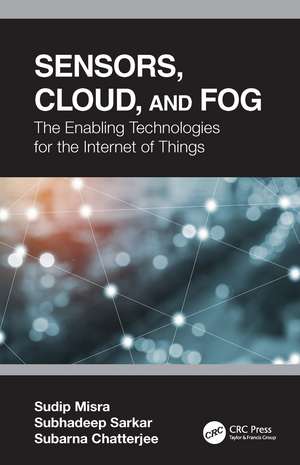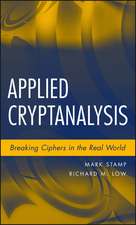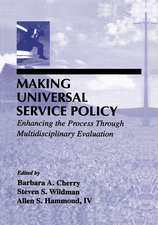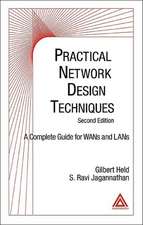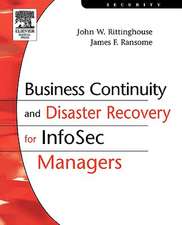Sensors, Cloud, and Fog: The Enabling Technologies for the Internet of Things
Autor Sudip Misra, Subhadeep Sarkar, Subarna Chatterjeeen Limba Engleză Paperback – 8 iul 2019
Classroom presentations and solutions to end of chapter questions are available to instructors who use the book in their classes.
Preț: 396.73 lei
Preț vechi: 558.96 lei
-29% Nou
Puncte Express: 595
Preț estimativ în valută:
75.92€ • 78.33$ • 64.26£
75.92€ • 78.33$ • 64.26£
Carte tipărită la comandă
Livrare economică 05-19 martie
Preluare comenzi: 021 569.72.76
Specificații
ISBN-13: 9780367196127
ISBN-10: 0367196123
Pagini: 284
Dimensiuni: 156 x 234 x 22 mm
Greutate: 0.42 kg
Ediția:1
Editura: CRC Press
Colecția CRC Press
ISBN-10: 0367196123
Pagini: 284
Dimensiuni: 156 x 234 x 22 mm
Greutate: 0.42 kg
Ediția:1
Editura: CRC Press
Colecția CRC Press
Public țintă
Academic and Professional Practice & DevelopmentCuprins
Contents
Foreword ..................................................................................................... xiii
Preface ..........................................................................................................xv
Acknowledgments ........................................................................................xix
About the Authors ........................................................................................xxi
PART I INTRODUCTION
1 History and Evolution of Cloud Computing .....................................3
1.1 Introduction .................................................................................. 3
1.1.1 Classification of Cloud Computing .................................... 4
1.1.2 Cloud Computing Deployment Models ............................. 4
1.1.3 Cloud Computing Service Models ...................................... 6
1.2 Computation in Cloud .................................................................. 7
1.2.1 Resource Management ........................................................ 8
1.2.2 Virtualization .................................................................... 11
1.2.3 Green Computing ............................................................. 16
1.3 Cloud Applications ...................................................................... 17
1.4 Summary ..................................................................................... 18
Reference ..................................................................................... 19
2 Sensor Networks and the Cloud ......................................................25
2.1 Wireless Sensor Networks ............................................................ 26
2.1.1 Background and Evolution ............................................... 26
2.1.2 Design of a Sensor Node ................................................... 32
2.1.3 Applications of Sensor Networks ...................................... 33
2.1.4 Challenges and Constraints ............................................... 34
2.2 Unification of WSNs with Cloud: Dawn of a New Era ............... 36
2.2.1 The Significance of Cloud Computing ............................. 36
2.2.2 How Does Integration Work? Example Scenarios ............. 37
2.2.3 Challenges ........................................................................ 40
2.3 Summary ..................................................................................... 41
Reference ..................................................................................... 43
3 Introduction to the Internet of Things ............................................47
3.1 Inception and Background ........................................................... 48
3.1.1 Definition ......................................................................... 48
3.1.2 Characteristics ................................................................... 50
3.2 IoT Middleware ........................................................................... 52
3.3 IoT Applications .......................................................................... 54
3.3.1 Healthcare ........................................................................ 55
3.3.2 Smart City Applications .................................................... 55
3.3.3 Smart Home ..................................................................... 55
3.3.4 Telecommunication .......................................................... 56
3.3.5 Supply Chain Management .............................................. 56
3.4 Open Research Challenges and Future Trends ............................. 56
3.5 Summary ..................................................................................... 59
Reference ..................................................................................... 60
PART 2 THE SENSOR-CLOUD PARADIGM
4 The Sensor-Cloud vs. Sensors and the Cloud ..................................65
4.1 What Is the Sensor-Cloud? .......................................................... 66
4.2 Background of the Sensor-Cloud ................................................. 67
4.2.1 Motivation of the Sensor-Cloud ....................................... 67
4.2.2 Actors of the Sensor-Cloud ............................................... 68
4.2.3 Architecture of the Sensor-Cloud ...................................... 69
4.2.4 Views of the Sensor-Cloud ................................................ 70
4.3 Sensor Virtualization .................................................................... 73
4.3.1 Configurations of Virtualization ....................................... 73
4.3.2 Characterization of Virtualization ..................................... 74
4.4 Sensor-Cloud Applications ........................................................... 76
4.4.1 Case Studies ...................................................................... 76
4.5 Some Insights .............................................................................. 79
4.5.1 Performance Metrics ......................................................... 79
4.5.2 Performance Evaluation .................................................... 81
4.6 Summary ..................................................................................... 84
Reference ..................................................................................... 86
5 Data Flow in the Sensor-Cloud ........................................................89
5.1 Introduction ................................................................................ 89
5.2 Composition of a Virtual Sensor .................................................. 89
5.2.1 Algorithms for Optimal Composition ............................... 91
5.2.2 CoV-I: Composition of VS within the Same Region ........ 91
5.2.3 CoV-II: Composition of VS and VSG across
Multiple Regions .............................................................. 92
5.2.4 Performance Evaluation of CoVs ...................................... 93
5.3 Data Management ....................................................................... 94
5.3.1 Data Caching .................................................................... 94
5.3.2 Data Transmission .......................................................... 101
5.4 Summary ................................................................................... 110
Reference ................................................................................... 112
6 Pricing and Networking in the Sensor-Cloud ................................115
6.1 Scenario for Pricing .................................................................... 116
6.2 The Model for Pricing ............................................................... 116
6.2.1 Assumptions of the Model .............................................. 117
6.3 pH: Pricing Attributed to Hardware .......................................... 119
6.3.1 Selection of the Next Hop Node .................................... 119
6.3.2 Context-Aware Pricing .................................................... 120
6.4 pI: Pricing Attributed to Infrastructure ...................................... 121
6.5 Real-Life Applicability: A Case Study ........................................ 123
6.6 Networking ................................................................................ 123
6.7 System Description .................................................................... 126
6.8 Formal Definition of the Problem .............................................. 126
6.9 Complexity Analysis .................................................................. 129
6.10 Summary ................................................................................... 130
Reference ................................................................................... 131
7 Sensor-Cloud for Internet of Things ..............................................133
7.1 Introduction .............................................................................. 133
7.2 Enabling IoT through Sensor-Cloud .......................................... 134
7.2.1 Contributions through Architecture ................................ 134
7.2.2 Contributions through Functionalities ............................ 137
7.2.3 Contributions through the Life Cycle ............................. 137
7.3 Summary ................................................................................... 139
Reference ................................................................................... 141
PART III FROM THE CORE TO THE EDGE: FOG
8 Fog: The Next-Gen Cloud .............................................................145
8.1 Introduction to Fog Computing ................................................ 146
8.1.1 Where Does Cloud Computing Fall Short? .................... 147
8.1.2 Definition ....................................................................... 149
8.1.3 Fog versus Other Computing Paradigms ........................ 151
8.1.4 Where There Is Fog, There Is Cloud .............................. 158
8.2 Characteristics of Fog Computing ............................................. 160
8.3 Advantages of Fog Computing ................................................... 161
8.4 Summary ................................................................................... 163
Reference ................................................................................... 164
9 Fog Computing Applications .........................................................167
9.1 IoT Applications and Fog Computing ....................................... 168
9.2 Fog Applications ........................................................................ 170
9.2.1 Healthcare and Well-being ............................................. 170
9.2.2 Smart Vehicle Management ............................................ 173
9.2.3 Smart City Applications .................................................. 175
9.2.4 Smart Data Management ................................................ 178
9.2.5 Other Emerging Application Sectors ............................... 180
9.3 Summary ................................................................................... 180
Reference ................................................................................... 181
10 Fog Architecture .............................................................................187
10.1 The Comprehensive Framework ................................................ 187
10.1.1 Communication and Network Model ........................ 189
10.2 Mathematical Model of the System ............................................ 190
10.3 Application Agnostic Fog Architectures ...................................... 195
10.3.1 Programming Models ................................................. 196
10.4 Application-Specific Fog Architectures ....................................... 199
10.4.1 Fog Architectures for Healthcare ................................ 199
10.4.2 Fog Architectures for Smart City Environments ......... 203
10.4.3 Other Application-Specific Fog Architectures ............. 205
10.5 Summary ................................................................................... 207
Reference ................................................................................... 208
11 Towards a “Green”-er Internet of Things ......................................213
11.1 Reference Model ........................................................................ 214
11.1.1 Assumptions ............................................................... 215
11.1.2 Reference Architecture ................................................ 215
11.2 Networking Model ..................................................................... 216
11.3 Performance Metrics .................................................................. 218
11.3.1 Power Consumption ................................................... 219
11.3.2 Service Latency ........................................................... 223
11.4 A Case Study: Simulation Setup ................................................. 226
11.4.1 Network Topology ..................................................... 226
11.4.2 Network Traffic .......................................................... 227
11.4.3 Performance Metrics ................................................... 227
11.5 A Case Study: Performance Evaluation ...................................... 228
11.5.1 Service Latency ........................................................... 228
11.5.2 Power Consumption ................................................... 229
11.5.3 CO2 Emission ............................................................. 230
11.5.4 Cost ............................................................................ 232
11.6 Summary .................................................................................... 232
Reference ................................................................................... 234
12 Security in the IoT .........................................................................237
12.1 Introduction ............................................................................... 237
12.1.1 IoT Security vs. Conventional Security ...................... 237
12.1.2 Difference between Security and Privacy .................... 238
12.2 Security in the IoT ..................................................................... 238
12.2.1 Protocol Stack for the IoT .......................................... 240
12.2.2 Security Threats in the IoT ......................................... 241
12.3 Misbehavior in M2M Communication ...................................... 244
12.3.1 Where Do We Stand? ................................................. 245
12.3.2 Problem Scenario ........................................................ 246
12.3.3 System Model ............................................................. 247
12.3.4 Operation ................................................................... 247
12.3.5 Quantitative Results ................................................... 249
12.4 Summary .................................................................................... 251
Reference ................................................................................... 253
Index ...........................................................................................................257
Preface ..........................................................................................................xv
Acknowledgments ........................................................................................xix
About the Authors ........................................................................................xxi
PART I INTRODUCTION
1 History and Evolution of Cloud Computing .....................................3
1.1 Introduction .................................................................................. 3
1.1.1 Classification of Cloud Computing .................................... 4
1.1.2 Cloud Computing Deployment Models ............................. 4
1.1.3 Cloud Computing Service Models ...................................... 6
1.2 Computation in Cloud .................................................................. 7
1.2.1 Resource Management ........................................................ 8
1.2.2 Virtualization .................................................................... 11
1.2.3 Green Computing ............................................................. 16
1.3 Cloud Applications ...................................................................... 17
1.4 Summary ..................................................................................... 18
Reference ..................................................................................... 19
2 Sensor Networks and the Cloud ......................................................25
2.1 Wireless Sensor Networks ............................................................ 26
2.1.1 Background and Evolution ............................................... 26
2.1.2 Design of a Sensor Node ................................................... 32
2.1.3 Applications of Sensor Networks ...................................... 33
2.1.4 Challenges and Constraints ............................................... 34
2.2 Unification of WSNs with Cloud: Dawn of a New Era ............... 36
2.2.1 The Significance of Cloud Computing ............................. 36
2.2.2 How Does Integration Work? Example Scenarios ............. 37
2.2.3 Challenges ........................................................................ 40
2.3 Summary ..................................................................................... 41
Reference ..................................................................................... 43
3 Introduction to the Internet of Things ............................................47
3.1 Inception and Background ........................................................... 48
3.1.1 Definition ......................................................................... 48
3.1.2 Characteristics ................................................................... 50
3.2 IoT Middleware ........................................................................... 52
3.3 IoT Applications .......................................................................... 54
3.3.1 Healthcare ........................................................................ 55
3.3.2 Smart City Applications .................................................... 55
3.3.3 Smart Home ..................................................................... 55
3.3.4 Telecommunication .......................................................... 56
3.3.5 Supply Chain Management .............................................. 56
3.4 Open Research Challenges and Future Trends ............................. 56
3.5 Summary ..................................................................................... 59
Reference ..................................................................................... 60
PART 2 THE SENSOR-CLOUD PARADIGM
4 The Sensor-Cloud vs. Sensors and the Cloud ..................................65
4.1 What Is the Sensor-Cloud? .......................................................... 66
4.2 Background of the Sensor-Cloud ................................................. 67
4.2.1 Motivation of the Sensor-Cloud ....................................... 67
4.2.2 Actors of the Sensor-Cloud ............................................... 68
4.2.3 Architecture of the Sensor-Cloud ...................................... 69
4.2.4 Views of the Sensor-Cloud ................................................ 70
4.3 Sensor Virtualization .................................................................... 73
4.3.1 Configurations of Virtualization ....................................... 73
4.3.2 Characterization of Virtualization ..................................... 74
4.4 Sensor-Cloud Applications ........................................................... 76
4.4.1 Case Studies ...................................................................... 76
4.5 Some Insights .............................................................................. 79
4.5.1 Performance Metrics ......................................................... 79
4.5.2 Performance Evaluation .................................................... 81
4.6 Summary ..................................................................................... 84
Reference ..................................................................................... 86
5 Data Flow in the Sensor-Cloud ........................................................89
5.1 Introduction ................................................................................ 89
5.2 Composition of a Virtual Sensor .................................................. 89
5.2.1 Algorithms for Optimal Composition ............................... 91
5.2.2 CoV-I: Composition of VS within the Same Region ........ 91
5.2.3 CoV-II: Composition of VS and VSG across
Multiple Regions .............................................................. 92
5.2.4 Performance Evaluation of CoVs ...................................... 93
5.3 Data Management ....................................................................... 94
5.3.1 Data Caching .................................................................... 94
5.3.2 Data Transmission .......................................................... 101
5.4 Summary ................................................................................... 110
Reference ................................................................................... 112
6 Pricing and Networking in the Sensor-Cloud ................................115
6.1 Scenario for Pricing .................................................................... 116
6.2 The Model for Pricing ............................................................... 116
6.2.1 Assumptions of the Model .............................................. 117
6.3 pH: Pricing Attributed to Hardware .......................................... 119
6.3.1 Selection of the Next Hop Node .................................... 119
6.3.2 Context-Aware Pricing .................................................... 120
6.4 pI: Pricing Attributed to Infrastructure ...................................... 121
6.5 Real-Life Applicability: A Case Study ........................................ 123
6.6 Networking ................................................................................ 123
6.7 System Description .................................................................... 126
6.8 Formal Definition of the Problem .............................................. 126
6.9 Complexity Analysis .................................................................. 129
6.10 Summary ................................................................................... 130
Reference ................................................................................... 131
7 Sensor-Cloud for Internet of Things ..............................................133
7.1 Introduction .............................................................................. 133
7.2 Enabling IoT through Sensor-Cloud .......................................... 134
7.2.1 Contributions through Architecture ................................ 134
7.2.2 Contributions through Functionalities ............................ 137
7.2.3 Contributions through the Life Cycle ............................. 137
7.3 Summary ................................................................................... 139
Reference ................................................................................... 141
PART III FROM THE CORE TO THE EDGE: FOG
8 Fog: The Next-Gen Cloud .............................................................145
8.1 Introduction to Fog Computing ................................................ 146
8.1.1 Where Does Cloud Computing Fall Short? .................... 147
8.1.2 Definition ....................................................................... 149
8.1.3 Fog versus Other Computing Paradigms ........................ 151
8.1.4 Where There Is Fog, There Is Cloud .............................. 158
8.2 Characteristics of Fog Computing ............................................. 160
8.3 Advantages of Fog Computing ................................................... 161
8.4 Summary ................................................................................... 163
Reference ................................................................................... 164
9 Fog Computing Applications .........................................................167
9.1 IoT Applications and Fog Computing ....................................... 168
9.2 Fog Applications ........................................................................ 170
9.2.1 Healthcare and Well-being ............................................. 170
9.2.2 Smart Vehicle Management ............................................ 173
9.2.3 Smart City Applications .................................................. 175
9.2.4 Smart Data Management ................................................ 178
9.2.5 Other Emerging Application Sectors ............................... 180
9.3 Summary ................................................................................... 180
Reference ................................................................................... 181
10 Fog Architecture .............................................................................187
10.1 The Comprehensive Framework ................................................ 187
10.1.1 Communication and Network Model ........................ 189
10.2 Mathematical Model of the System ............................................ 190
10.3 Application Agnostic Fog Architectures ...................................... 195
10.3.1 Programming Models ................................................. 196
10.4 Application-Specific Fog Architectures ....................................... 199
10.4.1 Fog Architectures for Healthcare ................................ 199
10.4.2 Fog Architectures for Smart City Environments ......... 203
10.4.3 Other Application-Specific Fog Architectures ............. 205
10.5 Summary ................................................................................... 207
Reference ................................................................................... 208
11 Towards a “Green”-er Internet of Things ......................................213
11.1 Reference Model ........................................................................ 214
11.1.1 Assumptions ............................................................... 215
11.1.2 Reference Architecture ................................................ 215
11.2 Networking Model ..................................................................... 216
11.3 Performance Metrics .................................................................. 218
11.3.1 Power Consumption ................................................... 219
11.3.2 Service Latency ........................................................... 223
11.4 A Case Study: Simulation Setup ................................................. 226
11.4.1 Network Topology ..................................................... 226
11.4.2 Network Traffic .......................................................... 227
11.4.3 Performance Metrics ................................................... 227
11.5 A Case Study: Performance Evaluation ...................................... 228
11.5.1 Service Latency ........................................................... 228
11.5.2 Power Consumption ................................................... 229
11.5.3 CO2 Emission ............................................................. 230
11.5.4 Cost ............................................................................ 232
11.6 Summary .................................................................................... 232
Reference ................................................................................... 234
12 Security in the IoT .........................................................................237
12.1 Introduction ............................................................................... 237
12.1.1 IoT Security vs. Conventional Security ...................... 237
12.1.2 Difference between Security and Privacy .................... 238
12.2 Security in the IoT ..................................................................... 238
12.2.1 Protocol Stack for the IoT .......................................... 240
12.2.2 Security Threats in the IoT ......................................... 241
12.3 Misbehavior in M2M Communication ...................................... 244
12.3.1 Where Do We Stand? ................................................. 245
12.3.2 Problem Scenario ........................................................ 246
12.3.3 System Model ............................................................. 247
12.3.4 Operation ................................................................... 247
12.3.5 Quantitative Results ................................................... 249
12.4 Summary .................................................................................... 251
Reference ................................................................................... 253
Index ...........................................................................................................257
Descriere
This book highlights several of today's research and technological challenges of translating the concept of the IoT into a practical, technologically feasible, and business-viable solution. The book discusses two novel technologies--sensor-cloud and fog computing--as the crucial enablers for the sensing and compute backcone of the IoT.
